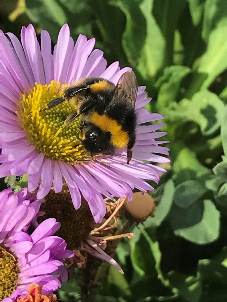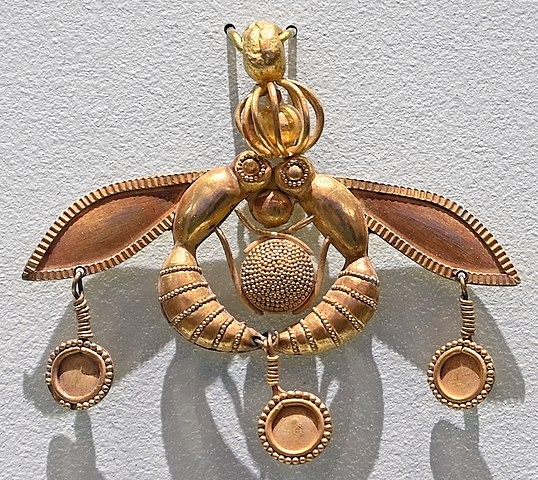Bees in Folklore, Religion, and Superstition

This is an adapted extract of a video I did recently for Pagan Aid to help raise awareness of their campaign to raise money for Bees for Development, an organisation that helps some of the poorest communities in the world create livelihoods through beekeeping. You can view the original video here.
There are over 250 species of bee in the UK and around 4,000 native species in the United States. Even humble bumblebees have at least 24 separate species, from orange and black red-tailed bumblebees to the classic white, yellow, and black tree bumblebees. However, it’s the honeybee that gets the most attention, generally, when it comes to folklore. That’s because we have had a pretty cool relationship with honeybees for about 40,000 years give or take. Archaeologists have unearthed weapons and tools held together partly with beeswax, rock art depicting bee hives, plus iconography from a range of ancient cultures shows that not only have we utilized bees for thousands of years, but we’ve kind of revered them quite a lot too.
Bees are the Tears of Ra
One of the first things to note about bees is that while there’s not tons of evidence of ancient beekeeping, what exists is quite widespread across the world. In Ancient Egypt, the legend was that bees were born from the tears of the Sun God Ra. Bees were also associated with royalty, no surprises there since royalty was considered literally divine in Ancient Egypt. Bees pop up all over Egyptian hieroglyphs, too. Honey was also used as a form of currency, and even as wedding dowries. For anyone looking for the spiritual significance of honey to the Ancient Egyptians, honey was used during the mummification process, although it’s worth noting that honey has some antibacterial properties and rarely spoils, so this could have had a practical element to it as well.

Melissae: The Bee Priestesses
Moving from Egypt to the Mediterranean, the British museum has some fabulous artifacts showing bees as sacred or revered creatures from Minoan and Archaic Greek periods. So we’re talking around Greece, between 2700 and 3700 years ago. One of these items is a gold bee which is highly ornate and presumed to be Minoan. And there’s an incredibly famous Minoan bee pendant which appears to show two bees guarding a stylise honeycomb. This pendant is still sometimes seen as a symbol for the modern revival of Minoan spirituality.
Author Laura Perry is an expert on Minoan deities, and she’s written a bit about the Melissae, a word related to the Greek for both Bee and Honey, but used in this context to refer to priestesses of a Bee goddess or a primary goddess strongly associated with bees and honey. Melissa was probably the name of the goddess, and later on the Ancient Greeks reduced that goddess to a nymph, attributed with the discovery of how useful honey was. Bees pop in Greek mythology over and over, including three bee maidens or nymphs being key in raising the Greek God Apollo and ensuring his gift of prophecy. Apollo’s son, Aristaeus, became the god of bee keeping.
Bees in the East
Heading more eastward, evidence of 3,000 year-old beekeeping was found in Israel for the first time back in 2007. The findings suggested two things: Firstly, that beekeeping had been going on for some time, because the hives and their placement were fairly advanced. The other was that the placement of the hives seemed to indicate that the locals had placed great value on the honey, going to great lengths to keep the hives safe.
In the Far East, there seem to be less instances of bee worship and reverence, even though bees are prevalent in most of these places and honey is used here too. There are still folk beliefs around bees, though. Bees often get linked to the cycles of life and death, and that was no different in China, where bee hives would be turned around after the death of their owner. A piece of writing from the 16th century Chinese writer tells us that families would look in on their hives every morning, and if the bees swarmed, it was a sign of exceptional good luck. Japan’s beekeeping history involved a relationship with honey as a medicine rather than simply a food, plus some sources state that the first beehive may have been primarily used for fortune telling, rather than honey!
Bees in Europe
All across Europe, there’s a ton of conjecture and assumption about the religious significance of bees, including many who link various goddess statues or iconography to bees with very little firm evidence to back this up. However, it’s clear that throughout history, we’ve been able to recognise the restorative, regenerative nature of bees; their reverence for family and community; their resilience; their links to literal nutrition and their links to life and death, thanks to the sometimes vicious inner politics of the hive. Bees go, they come back, and that cycle is very obvious to anyone who lives with even the slightest connection to nature.
Do you have any fascinating bee folklore or superstitions to share? Tell us on social media at Facebook or Twitter.
***
About the Author:
Mabh Savage is a Pagan author, poet and musician, as well as a freelance journalist.
She is the author of A Modern Celt: Seeking the Ancestors & Pagan Portals – Celtic Witchcraft: Modern Witchcraft Meets Celtic Ways.

No comments:
Post a Comment